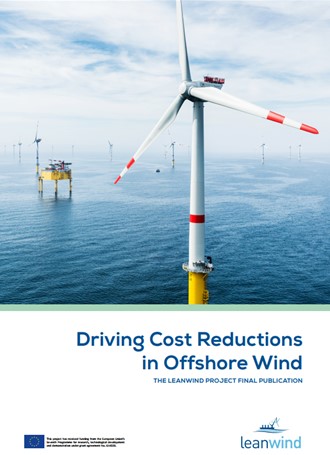- Driving Cost Reductions in Offshore Wind - The LEANWIND Project Final Publication
The final report of the LEANWIND project is finished and can be found here!
The executive summary can accessed here.
-
LEANWIND Project Video
The LEANWIND project recently released a new video overview of the project:
-
Construction, Deployment, and Decommissioning
The support structures and substructures necessary for offshore wind farms construction, deployment and decommissioning phases need to be improved. Among other objectives, this set of activities aims at ameliorating the temporary stability of structures during the deployment phase, designing new types of gravity bases to reduce installation time and at finding innovations concerning the seabed preparation.
Deliverable 2.1, Executive summary: WP Framework/Industry Challenges Report – construction, deployment and installation
Read the full report here.
Deliverable 2.2, Executive summary: supply chain report
Deliverable 2.3, Executive summary: Novel turbine deployment and installation challenges
Deliverable 2.4, Executive summary: Fixed Platform Design Framework
Deliverable 2.5, Executive summary: Floating Platform Design framework
Deliverable 2.6, Executive summary: Substructure Selection Recommendation
Summary description of LEANWIND 8 MW reference turbine
Extreme wave testing of floating wind energy platform. Watch the video!
-
Novel Vessels and Equipment
Primary vessels types that are used for both wind farm installation and O&M need to be more efficient; LEANWIND aims at developing new solutions for vessels currently in use and at designing new vessels - tailored to meet industry requirements.
Deliverable 3.1, Executive summary: WP Framework/Industry Challenges Report – novel vessels and equipment
Read the full report here.
Deliverable 3.2, Key design parameters and criteria related to installation and maintenance vessels design; their layouts, crane operations and access systems
Deliverable 3.3, Executive summary: TRL approach results for selection of installation vessel, maintenance vessel, access system and lift operations concepts
Deliverable 3.4, Executive summary: Novel maintenance vessel, access systems and installation vessels design report.
Deliverable 3.5, Executive summary: Final novel maintenance vessel, access systems and installation vessels concepts design package
-
Operation and Maintenance strategies
O&M phases in the offshore wind farms are crucial. Procedures need to be optimised, especially in the far-shore, in deep water and other more exposed locations. This package of activities also wants to reduce OPEX costs by improving condition monitoring and remote presence systems, in order to minimize the need for on-site corrective maintenance.
Deliverable 4.1, Executive summary: WP Framework/Industry Challenges Report – O&M
Read the full report here.NAAS remote presence prototype - video here
Deliverable 4.2, Executive summary: Optimised maintenance and logistic strategy models
Deliverable 4.3, Executive Summary: Remote presence prototype development
Deliverable 4.4, Executive Summary: Condition monitoring software and RAMS tool kit or wind turbines
Deliverable 4.5, Executive Summary: Framework for risk-based optimal planning of O&M and inspections
Deliverable 4.6, Executive Summary: Optimisation Algorithms for Dynamic Scheduling of Preventive and Corrective O&M
Deliverable 4.7, Executive Summary: O&M, Integration of tools and systems
-
Integrated Logistics
The final cost of energy produced by off-shore wind farms can be reduced by rendering the whole logistics system more efficient throughout the wind farm supply chain lifecycle – from installation and O&M to the decommissioning phase. The use of lean principles will help in defining the key industry challenges, analysing the separate parts composing the offshore wind supply chain – such as on-land transport and ports- and optimising them. In July 2014 the first results will be available.
Deliverable 5.1, Executive summary: WP Framework/Industry Challanges Report - Supply Chain and Logistics
Read the full report here.
Deliverable 5.2, Executive summary: GIS database of manufacturing facilities, transportation links and port locations
Deliverable 5.3, Ports suitability assessment for offshore wind development-Case studies report
Deliverable 5.4, Executive summary: Study of on-land transport system limitations
Deliverable 5.5, Executive summary: Decision making model for port layout/configuration selection
Deliverable 5.6, Executive Summary: Mathematical optimisation models and methods for transport systems
Deliverable 5.7, Executive Summary: Holistic supply chain optimisation model
-
System Integration
The results, developments and achievements of all the above-mentioned core sets of activities are brought together into a comprehensive approach that takes into account, once again, the entire lifecycle of the offshore wind farm from early logistics to dismantling and ensures transferability of results to the industry.
Deliverable 6.3, Executive Summary: Health & safety risk control measures and required personnel skills
Read the full report here.
Deliverable 6.4, Executive Summary: Roadmap for the integration of component innovations in large offshore wind farms/arrays
Deliverable 6.5, Executive Summary: Training programs to optimise installation and O&M services for offshore wind farms
Health & Safety risk control measures and required personnel skills
-
Testing and Validation of Tools and Technologies
Integrated technologies and tools developed within the project need to be demonstrated and validated through simulation, field demonstration -using real full-scale projects- and case-study demonstration based on real data. This package of activities is fundamental to prove the successful applicability of new technologies and tools to the offshore wind industry.
Deliverable 7.2, Executive summary: Case study validation of combined financial and logistics tools
Deliverable 7.3, Executive summary: Use of simulation for O&M and Installation phase scenarios
Deliverable 7.4, Executive summary: Field testing activities report
-
Economic and Market Assessment
The new results achieved by the project need to be placed in an economic context. LEANWIND demonstrates that system optimisations and technology innovations have direct cost-saving benefits from which the whole wind industry will benefit. Offshore wind business and economic models that may encourage new sources of investment need to be examined. Moreover, the aim of the Economic and Market Assessment phase is to develop a commercialisation and implementation strategy that will ensure LEANWIND’s solutions to be effectively implemented.
Deliverable 8.1, Executive summary: new offshore wind business models, financing and risk assessment
Deliverable 8.2, Executive summary: Economics Model Report
Deliverable 8.3, Executive summary: Integrated Financial and Logistics Model
Deliverable 8.4, Executive summary: Assessment of existing market impact and market creation potential of project innovations
Deliverable 8.5, Full report: Environmental and non-technical impacts of LEANWIND project innovations
Deliverable 8.6, Executive summary: Viability and Implementation Roadmap and Strategy Document
Read the full report here.
